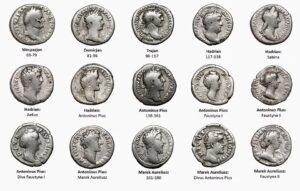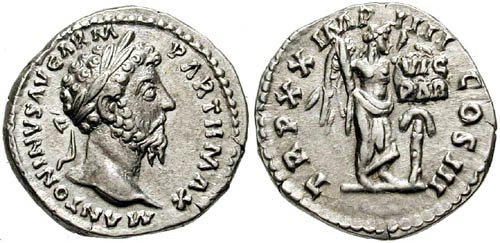Roman Silver Denarius: Value, History & Collector’s Guide
Introduction – The Silver That Built the Roman Empire
Every empire runs on trust, and Rome built its trust on silver — the denarius.
From the Republic’s wars to the height of imperial glory, the Roman denarius coin was more than currency. It was a message of power, unity, and divine right. Its glint told soldiers they were paid, merchants they were secure, and citizens that Rome endured.
Today, collectors pursue the Roman silver denarius not just for beauty, but because it still whispers the empire’s story — in Latin, in silver, in eternity.
🏛️ What Was the Roman Denarius?
The Roman denarius (plural: denarii) was introduced in 211 BC during the Second Punic War. It was the standard silver coin of the Roman currency system for nearly five centuries.
| Specification | Details |
|---|---|
| Metal | Silver (usually 90–98% pure) |
| Weight | 3.8 – 4.5 g |
| Value | Initially 10 bronze asses (hence the “X” mark) |
| Diameter | 18 – 20 mm |
| Era of Use | 211 BC – mid-3rd century AD |
The word denarius comes from deni, meaning “containing ten.” It set the foundation for future currencies — denier, dinero, denaro, and even dinar.
⚖️ The Evolution of the Roman Currency Denarius
1️⃣ The Republican Denarius (211–27 BC)
-
Obverse: Helmeted Roma head.
-
Reverse: Dioscuri (Castor & Pollux) galloping.
-
Symbolized civic virtue and martial courage.
2️⃣ The Imperial Denarius (27 BC–3rd Century AD)
Under Augustus, the denarius transformed:
-
Obverse: Emperor’s portrait (living or deified).
-
Reverse: Deities, temples, or triumphs.
-
Used to broadcast propaganda and divine legitimacy.
💬 Every emperor’s reign began with new coins — their “press release” to the empire.
💎 The Silver Standard & Debasement
At its peak, the Roman silver denarius had almost pure silver. But as wars drained Rome’s treasury, emperors reduced purity:
| Emperor | Date | Silver Purity | Result |
|---|---|---|---|
| Augustus | 27 BC | 98 % | Golden Age stability |
| Nero | AD 54 | 93 % | Minor debasement |
| Septimius Severus | AD 193 | 70 % | Military expansion |
| Caracalla | AD 212 | 55 % | Crisis inflation begins |
| Gallienus | AD 260 | < 20 % | Collapse of the denarius |
By AD 270, the denarius had effectively died, replaced by the antoninianus — a larger but lower-silver coin.
⚠️ When silver vanished from Roman coins, so did faith in Rome’s economy.
🔍 Identifying a Genuine Roman Denarius Coin
-
Weight: 3.2–4.0 g is typical for real silver issues.
-
Material: Silver or billon (silvery appearance, not gray).
-
Design: Fine, realistic portraits; clear Latin legends.
-
Strike: Sharp detail, off-center edges are normal.
-
Sound: Real silver “rings”; fakes sound dull.
If you’re unsure, verify through NGC Ancients, Forvm Ancient Coins, or British Museum references.
💰 Roman Denarius Value (2025 Market Overview)
| Type | Example | Condition | Average Price (USD) | Notes |
|---|---|---|---|---|
| Republican Roma/Dioscuri | 2nd c. BC | VF | $150 – $350 | Scarce & historical |
| Augustus Denarius | “CAESAR AVGVSTVS” | VF – XF | $400 – $900 | Imperial pioneer |
| Tiberius “Tribute Penny” | AD 14–37 | VF – XF | $700 – $1 200 | Biblical connection |
| Nero / Vespasian | 1st c. AD | VF | $300 – $600 | Collectible artistry |
| Marcus Aurelius | AD 161–180 | VF | $200 – $450 | Stoic philosopher coin |
| Severan / Late Imperial | AD 200–235 | F – VF | $100 – $250 | Educational starter coins |
📈 Roman denarii in high-grade silver have appreciated 20–40 % in the past 3 years.
🏦 Buying Authentic Roman Denarii
When searching roman denarius for sale, always check:
-
Certification: NGC, PCGS, or dealer provenance.
-
Dealer Reputation: CNG, Roma Numismatics, Leu Numismatik, or VCoins.
-
Return Policy: Essential for authenticity disputes.
Avoid listings that use vague terms like “ancient-style coin” — these are modern replicas.
📚 Symbolism on the Roman Silver Denarius
Each emperor used imagery as propaganda:
| Emperor | Obverse | Reverse Theme | Message |
|---|---|---|---|
| Augustus | Youthful laureate | Victory on globe | Pax Romana begins |
| Tiberius | Stern, calm | Seated Livia as Peace | Stability |
| Nero | Bearded, artistic | Lyre or temple | Divine creativity |
| Trajan | Heroic bust | SPQR Victory | Expansion |
| Marcus Aurelius | Mature philosopher | Fortuna | Wisdom through endurance |
🏺 To read a denarius is to read Rome’s autobiography in silver.
🧩 Why Collectors Value the Denarius
-
Accessible ancient artifact: Many under $300.
-
Tangible link to emperors: Portraits of real historical figures.
-
Investment-grade silver: Intrinsic metal + cultural worth.
-
Educational centerpiece: Ideal for new collectors and students of history.
💬 Each denarius connects your hands to the pulse of Roman civilization.
🔗 Internal NumisDon Connections
-
Roman Coins: A Journey Through Ancient Currency
-
Top 25 Most Valuable Ancient Coins Ever Sold
-
How to Identify and Authenticate Ancient Coins
-
Greek Coins of Athens – The Owl That Defined Currency
-
Roman Aureus Coins: Gold of the Emperors
💬 FAQs – Roman Denarius
Q 1. How much is a Roman denarius worth?
Anywhere from $100 to $1 200, depending on emperor, rarity, and condition.
Q 2. Are all denarii silver?
Yes, traditionally. Late issues were debased but still had some silver content.
Q 3. What was a denarius worth in ancient Rome?
Roughly a soldier’s daily wage — comparable to $100–150 in modern terms.
Q 4. How do I buy safely?
Stick to trusted dealers, certified slabs, or auctions with provenance.
Q 5. Is the Tiberius denarius really the “Tribute Penny”?
Yes — believed to be the coin referenced in the New Testament.
🏺 Conclusion – The Legacy of Silver and Empire
The Roman denarius is more than a numismatic object — it’s civilization’s signature in metal.
Its silver shimmer once paid armies, built temples, and carried emperors’ faces into eternity.
Two thousand years later, its legacy endures — proof that trust, artistry, and value can outlive empires themselves.
💬 To own a denarius is to hold the empire that never truly died.
Author: Dr. Elena Voss – Numismatist & Roman Currency Specialist
